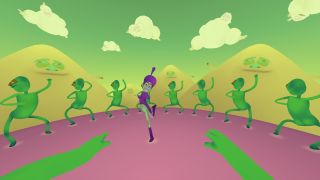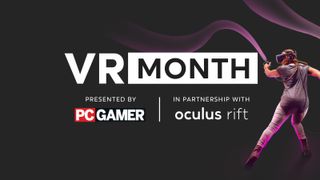Fringe VR is home to some of the PC's weirdest, coolest experimental games
Shake your butt or live inside someone else's brain: Indie devs are doing great (and strange) things in virtual reality.

One of the glowing user reviews for interactive VR music video Old Friend points out that though the experience only lasts for three minutes, they've spent nearly two hours listening and playing. It's just that much fun to be part of a cartoon world where clouds smile as you shake your booty at them.
VR tends to work best for short experiences—and when those experiences are really good, or just really different, we may well return to them dozens of times. For some designers, the limitation of how long someone will want to wear a headset is actually strength. It inspires them to take ideas that wouldn't work stretched over a 60-hour videogame and let them stand on their own. The creativity that approach enables means that games like Old Friend and Butts: The VR Experience (both created by Tyler Hurd) can find an audience, and that's no bad thing. Some of today's weirdest, coolest experimental indie games are happening in virtual reality.
On the more interactive side of VR, there are experiments like Mike Harris's projects. Homunculus is a game about being inside someone else's brain, formulating ideas by connecting nodes of thoughts as they cluster around you, while Virtual Strangers lets people meet over the internet in a digital desert and collaborate by drawing with their hands (and a set of Leap Motion controls). In one demonstration a player draws a bicycle and another pretends to ride it, then they shrink it down and create a bumpy landscape to traverse. They play tic-tac-toes and draw monsters, all while appearing as a set of floating hands and a mouth.
"From the start I was amazed at how much emotion and personality could be conveyed just by tracking someone’s head and hands," Harris says. He'd been toying around with the Leap Motion and been impressed by the subtlety of expression that was possible when small movements are accurately conveyed.
What began as a technical experiment became a social one when actual people were let loose in his simulation. As Harris puts it, "there were people who would approach and engage with me, asking me where I was and questions about the experience and how it was made, there were the people that acknowledged me at the outset but felt perfectly happy to draw on their own during our minutes together, and there were the few that remained skeptical of my humanity, despite my assuring them that I was in fact a real person located several latitudes away."
The physical aspect of drawing with their hands was a leap for some players, and they reacted to that in different ways as well. "There were people who stood in one place and drew randomly at arm’s length, creating a dome of squiggles around their head," he says. "there were the people that drew extruded two-dimensional drawings that looked correct from their perspective but failed to line up from any other angle, and there were the people that instantly understood the three-dimensionality of drawing from the outset."
Doing unusual things with the range of motion available in VR can be a strange and disorienting experience. The sensation of having a trunk attached to your face in Dumpy: Going Elephants sticks with you, even though it only takes four minutes to walk through its colorful playground world demolishing everything in your path. Disorientation is something VR does well.
The biggest gaming news, reviews and hardware deals
Keep up to date with the most important stories and the best deals, as picked by the PC Gamer team.
Of course, the main way it does that is by letting you visit an odd location. Self Portrait (Interior) is a vivid example, a guided tour of the inside of artist Theo Triantafyllidis that begins by walking into his mouth. The dark world of A Large Quantity of Mushrooms, with its staring green-eyed girls, train ride across the water, and staring cat obelisks, is another one that will lodge itself in your brain.
And then there's Double Shot. Here's a game about shooting guns, which is one of the bog-standard videogame interactions that works in VR, just like driving cars and piloting spaceships, but it's also a game about tending a bar. The thesis of Double Shot is that pretending to be Tom Cruise in Cocktail would actually be just as fun as pretending to be Tom Cruise in Mission Impossible.
According to developer Chris Burden "there’s a certain mysticism to being a bartender. A certain coolness. We wanted you to feel like a real badass. But we wanted people to feel like they were doing it themselves. Bartending was one of the best interactions we found in VR, especially when you can do things like spin and catch bottles and then pop off a couple of shots at an enemy. Shooting in VR is fun, and I think it definitely has its place, but for us we wanted to make a game that had a bit more going on."
Something VR designers have been learning as they go is exactly how much abstraction works in this new medium. Double Shot is not a game of precisely adding four ounces of gin to a martini because measuring isn't part of the fantasy of bartending that's enjoyable—it's the flair, juggling and shaking and hurling things together before adding an umbrella to top it all off.
Also: "Throwing a whole pineapple into a glass to get a slice is really fun."
Where Double Shot gets properly weird is in the aesthetics. The Hotline Miami synthwave look gains something from not being a pixelated 2D map and instead being a place you inhabit, like a Knight Rider fantasy. "When you tell someone that you’re making a VR bartending action/shooter set in an alternative 80s with a Sentient Bar as your best friend it definitely interests people," as Burden puts it.
While the best-selling VR games are usually rhythm games, zombie shooters, and adaptations of Bethesda RPGs, there's still room for oddness and surprise at the fringes—whether in experimental games or ones that sneak the unusual into VR implementations of more traditional concepts. Burden likens this to the silent movie period, suggesting that the technology is still half-finished and we've yet to see everything VR is capable of. "We’re doing OK," he says, "but I think a lot is going to change in the next few years."
Harris is excited for possible new ways of interacting that are more natural and more powerful, and he's also excited about "VR's ability to connect people, especially since so many, myself included, are increasing living apart from family and friends." He's realistic about the place his games and others like them are likely to occupy as VR grows in popularity, however, remaining on the fringes even as the technology is slowly improved and adopted.
"I think fringe VR will always thrive regardless of what happens with mainstream VR," he says. "There are millions of headsets out there now and passionate developers interested in creating and sharing knowledge, code, and experiences."
And thank god for that. As interesting as it will be to see ambitious, long-form games created in VR, there should always be room for things like Pants Pants Revolution as well.

Jody's first computer was a Commodore 64, so he remembers having to use a code wheel to play Pool of Radiance. A former music journalist who interviewed everyone from Giorgio Moroder to Trent Reznor, Jody also co-hosted Australia's first radio show about videogames, Zed Games. He's written for Rock Paper Shotgun, The Big Issue, GamesRadar, Zam, Glixel, Five Out of Ten Magazine, and Playboy.com, whose cheques with the bunny logo made for fun conversations at the bank. Jody's first article for PC Gamer was about the audio of Alien Isolation, published in 2015, and since then he's written about why Silent Hill belongs on PC, why Recettear: An Item Shop's Tale is the best fantasy shopkeeper tycoon game, and how weird Lost Ark can get. Jody edited PC Gamer Indie from 2017 to 2018, and he eventually lived up to his promise to play every Warhammer videogame.
Most Popular



